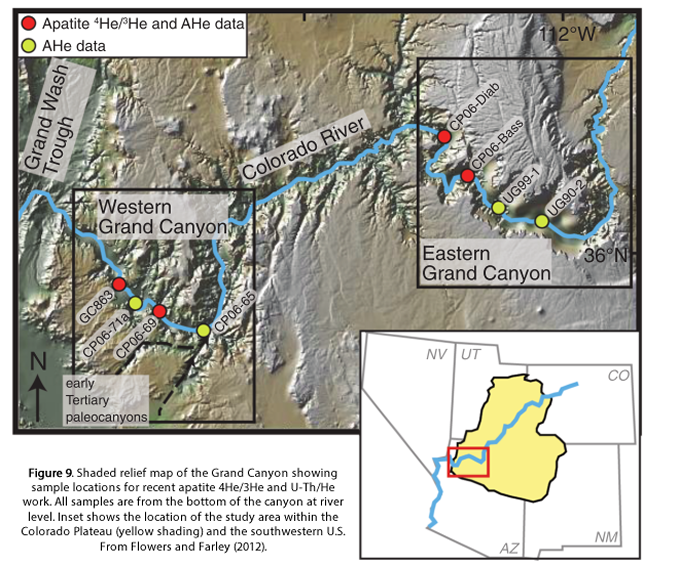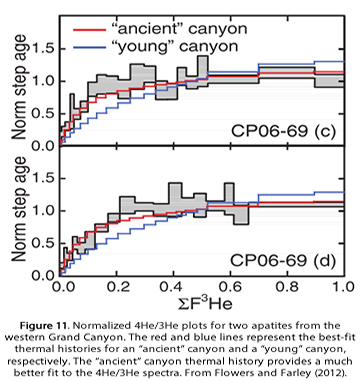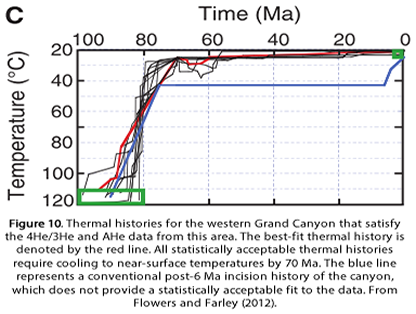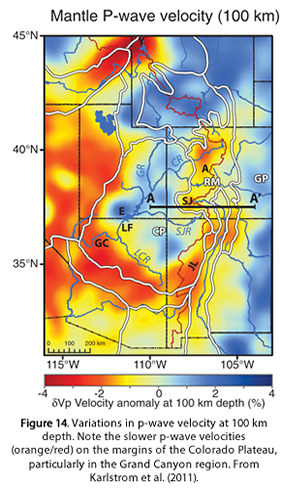SYNTHESIS AND TECTONIC IMPLICATIONS
While the debate over the age of the Grand Canyon remains unresolved, recent 4He/3He work in the area (Flowers and Farley, 2012) provides reproducible data to support the “old” canyon model in the western Grand Canyon and the “young” canyon model in the eastern Grand Canyon (Fig. 9). This two-stage model for canyon incision has important implications for the tectonic history of the Colorado Plateau, one of the more enigmatic features of the western U.S.

Joint inverse modeling of 4He/3He spectra and traditional apatite U-Th/He (AHe) dates from apatite samples in the western canyon yields a best-fit thermal history characterized by rapid cooling starting at ~80 Ma to near-surface temperatures (~30 °C) by the Late Cretaceous (~70 Ma) (Fig. 10; Flowers and Farley, 2012). This thermal history demands cooling of river-level basement rocks in the western canyon to near-surface temperatures by ~70 Ma, which implies incision of the western canyon to within a few hundred meters of its current level (assuming a 20-25 °C/km geothermal gradient and surface temperature of 25 °C) (Flowers and Farley, 2012). This “ancient” canyon is proposed to have been carved by a northeast-flowing river at that time based on transport directions recorded by gravels found on the southern rim of the canyon (Young, 1966; Wernicke, 2011). It is important to note that while canyon incision currently provides the most plausible  mechanism for cooling these rocks to near-surface temperatures, it is likely not the only possible mechanism.
mechanism for cooling these rocks to near-surface temperatures, it is likely not the only possible mechanism.

Flowers and Farley also performed forward modeling where representative thermal histories for an “ancient” canyon and a “young” canyon were fit to the observed 4He/3He spectra for apatite samples within the western canyon. As Figure 11 illustrates, the “ancient” canyon thermal history provides a much better fit to the 4He/3He profile (which, to emphasize, is a sensitive function of the sample’s t-T history; e.g. Shuster and Farley, 2004) than the “young” canyon model, which produced a statistically unacceptable fit (Flowers and Farley, 2012). Thus, the thermochronologic data in the western Grand Canyon does not provide evidence for the strong post-6 Ma cooling signal predicted by the “young” canyon model. 
Similar joint inverse modeling of 4He/3He spectra and traditional AHe dates from apatite samples in the eastern canyon yields a best-fit thermal history characterized by multiple stages of cooling during the Cenozoic with final cooling to near-surface temperatures occurring between 20 Ma and the present (Fig. 12; Flowers and Farley, 2012). This thermal history contrasts significantly with that for the western canyon (Fig. 10), and importantly, permits (but does not demand) post-6 Ma incision of the eastern canyon by the modern Colorado River as advocated by those in favor of the “young” canyon model. The best-fit thermal history (shown in red on Fig. 12) provides an excellent fit to observed 4He/3He profiles for both low and high uranium apatites.
Following the publication of this 4He/3He study of the Grand Canyon, which supported a controversial “ancient” origin to the western portion of the canyon, two technical comments to the original paper were published in Science. The first, authored by Karlstrom et al. (2013), disputed the validity of the thermochronologic data and accompanying interpretations presented by Flowers and Farley (2012), citing apatite fission track and U-Th/He data from an unpublished abstract and MSc thesis (since published; Lee et al., 2013) to support their case. The particular sample highlighted by this technical comment indicated cooling to ~40 °C by 25 Ma in the western canyon, leading the authors to cite the possible role of radiation damage effects in apatite and faulting within the canyon to explain the discrepancy between this data and the 4He/3He and AHe data of Flowers and Farley. However, the latter authors contend that Karlstrom et al. ignored two reproducible AHe analyses from the Lee et al. study that are consistent with the “ancient” canyon model and rather focused on a single sample characterized by extreme scatter and regionally anomalous results. Flowers and Farley (2013) maintain that the reproducibility of their results and those of Lee et al. (2013) serve to counter speculation regarding the effects of faulting and apatite radiation damage.
Lucchitta (2013) also provided a technical comment to the original paper. This comment challenged the viability of an “ancient” model for the western canyon on the basis of geologic evidence from Grand Wash Trough at the western terminus of the canyon. Specifically, Lucchitta cites a lack of diagnostic deposits in the ~13 to 6 Ma Muddy Creek Formation from a westward paleodrainage running through the proposed “ancient” canyon (essentially referring to the previously discussed “Muddy Creek problem”). Flowers and Farley (2013) countered this argument by reiterating that the absence of pre-6 Ma deposits in Grand Wash Trough does not preclude carving of the western canyon before that time. In the model of Wernicke (2011), a Miocene river running through a carved western canyon would not have been expected to contribute much detritus to the trough because of arid conditions and a much smaller drainage area, with any possible evidence being removed when the Colorado River was fully integrated at ~6 Ma.
Following this initial debate, the proposed “ancient” western canyon that is supported by 4He/3He and AHe data remains viable but not wholly conclusive. This model – where river-level rocks in the western Grand Canyon cooled below ~30 °C by ~70 Ma – is based upon multiple 4He/3He spectra and a total of 29 reproducible apatite helium analyses from two different laboratories (Flowers and Farley, 2013). However, certain geologic relationships in the region still appear to conflict with this interpretation of the data (but do not seem to go as far as to preclude it). In particular, the presence and horizontality of the 19 Ma Separation Canyon basalt and the underlying Buck and Doe conglomerate across an extensive portion of the Hualapai Plateau on the southern rim of the western canyon remains problematic to the existence of an almost fully carved canyon at that time (Young, 2011). Many outstanding questions about the age of the Grand Canyon remain, including the role of documented Early Tertiary paleocanyons within 10 km of the modern western canyon, the mechanisms and history of drainage integration, the potential for infilling of an “ancient” western canyon by Eocene gravels, and the apparent dichotomy between eastern and western canyon carving.
Tectonic Implications
The age of the Grand Canyon has important implications for the Cenozoic tectonic history of the western U.S., specifically in regards to the Colorado Plateau. At ~80 Ma, the entire plateau was located roughly at sea level as indicated by widespread Late Cretaceous marine sedimentary rocks in the area (Bond, 1976). The subsequent uplift history of the plateau has been a major point of debate in western U.S. tectonics (e.g. Flowers et al., 2008; Karlstrom et al., 2011), and presumably should be reflected in the histories of major erosional features on the plateau surface like the Grand Canyon. In addition, different proposed phases of uplift on the Colorado Plateau have typically been linked to different driving mechanisms (Sevier crustal thickening, Laramide flat slab, mantle buoyancy, etc.). Therefore, the timing of Grand Canyon carving also may help assess the validity of these proposed geodynamic mechanisms.

 The “ancient” canyon model invokes incision of the canyon to near modern levels by ~70 Ma (Flowers and Farley, 2012). To cut the western canyon to 1-1.5 km depth, the southwestern portion of the plateau must have been uplifted by that amount. A minimum of 1.2 km of uplift at this time is required by the presence of paleocanyons on the Hualapai Plateau with ~1200 m of relief (Elston and Young, 1991; Flowers et al., 2008). The eastern Grand Canyon may have also had ~1 km of relief at this time based on AHe data (but not below the present plateau surface) (Flowers et al., 2008). Thus, it appears likely that the southwestern margin of the Colorado Plateau underwent kilometer-scale uplift in the Early Tertiary while the center of the plateau remained near sea level (Flowers et al., 2008). This episode of uplift can be reasonably linked to Sevier tectonism – crustal thickening and associated mechanisms – on the western margin of the plateau. Substantial elevation gain of this part of the plateau in the Early Tertiary is consistent with existing clumped isotope paleoelevation data suggesting that the plateau remained relatively high throughout the Tertiary (e.g. Huntington et al., 2010). The timing of this elevation gain is also consistent with the major tectonic features in existence at that time (Fig. 13). With the presence of a major continental arc and Sevier crustal thickening to the west, it is logical that the regional trunk drainage would flow northeastward towards the Western Interior Seaway and carve the western canyon into the uplifting western margin of the plateau.
The “ancient” canyon model invokes incision of the canyon to near modern levels by ~70 Ma (Flowers and Farley, 2012). To cut the western canyon to 1-1.5 km depth, the southwestern portion of the plateau must have been uplifted by that amount. A minimum of 1.2 km of uplift at this time is required by the presence of paleocanyons on the Hualapai Plateau with ~1200 m of relief (Elston and Young, 1991; Flowers et al., 2008). The eastern Grand Canyon may have also had ~1 km of relief at this time based on AHe data (but not below the present plateau surface) (Flowers et al., 2008). Thus, it appears likely that the southwestern margin of the Colorado Plateau underwent kilometer-scale uplift in the Early Tertiary while the center of the plateau remained near sea level (Flowers et al., 2008). This episode of uplift can be reasonably linked to Sevier tectonism – crustal thickening and associated mechanisms – on the western margin of the plateau. Substantial elevation gain of this part of the plateau in the Early Tertiary is consistent with existing clumped isotope paleoelevation data suggesting that the plateau remained relatively high throughout the Tertiary (e.g. Huntington et al., 2010). The timing of this elevation gain is also consistent with the major tectonic features in existence at that time (Fig. 13). With the presence of a major continental arc and Sevier crustal thickening to the west, it is logical that the regional trunk drainage would flow northeastward towards the Western Interior Seaway and carve the western canyon into the uplifting western margin of the plateau.
The “young” canyon model postulates that the Grand Canyon was carved to modern levels in the last 6 Ma (Karlstrom et al., 2008). In this model, the rapid incision of the canyon would require substantial recent uplift of the plateau if the incision predated the ~6 Ma integration of the Colorado River; if incision postdated that integration, tectonic uplift would not necessarily be required because the drainage integration itself could facilitate the incision (Karlstrom et al., 2012). The mechanism paired with proposed Late Tertiary uplift of the plateau is mantle-driven buoyancy and flow. Geo-physical imaging indicates the presence of low-velocity mantle beneath the southwest margin of the plateau and geodynamic models indicate that the observed variation in mantle velocities beneath the region could be responsible for 400-800 m of surface uplift (Fig. 14; Karlstrom et al., 2011; 2012).
If the western Grand Canyon is indeed “ancient” and the eastern Grand Canyon “young”, this dichotomy may indicate that the incision of the canyon is driven by both tectonic (uplift) and non-tectonic (drainage integration) events. Future work to better resolve the timing of Grand Canyon incision, building upon the 4He/3He work discussed here, could be paired with more direct approaches to assessing Colorado Plateau elevation (e.g. improved paleoaltimetry) to better address unresolved questions of this nature. The current configuration of the Grand Canyon (Fig. 15) continues to inspire important questions regarding why rivers incise kilometer-scale canyons, how major erosional landscapes evolve over tens of millions of years, and how these processes are linked to regional tectonic processes (such as plateau uplift) and underlying geodynamic mechanisms.
